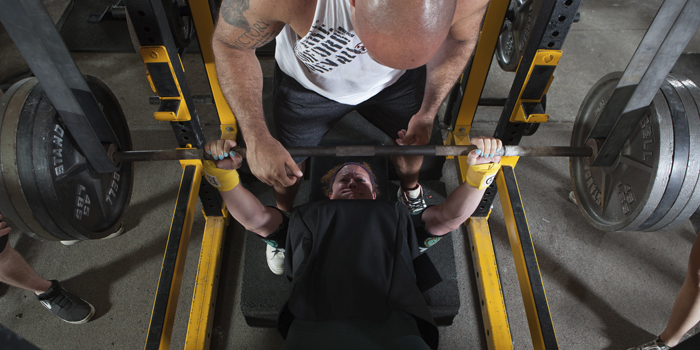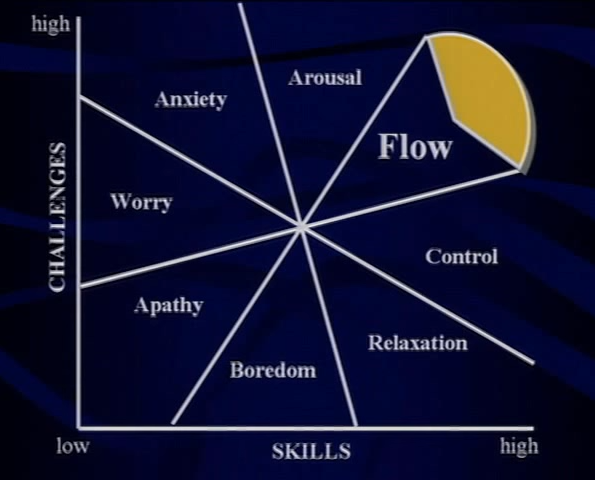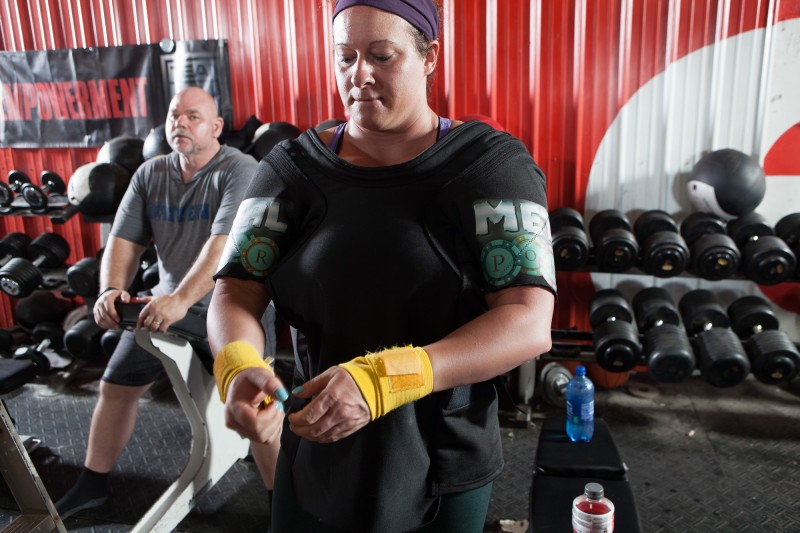
If you’re on this website reading this article, you are looking to get better at your sport. It doesn’t matter if it is powerlifting, football, coaching, or tiddlywinks. You are trying to become the best version of yourself in that sport/job/activity as you can.
If the above is true, then you are also familiar with the idea of having certain games or training sessions when you feel as though everything you do is effortless. In this “zone,” you find yourself almost predicting what the opponent will do before he or she does it, and you see problems arise and solve them instantly. You seem to be able to do nothing wrong. Time slows down to a crawl or passes in the blink of an eye, and you can feel as though your body and your mind are fully connected. It is the utmost of human performance, and you feel invincible.
RECENT: Self-Efficacy: The Science of Getting Shit Done
Artists, writers, and researchers may also feel this way when they work on a given project for hours and hours on end, tirelessly, and they look up to realize that 12 hours have passed and that they have not eaten or slept. They are laser focused on the task at hand, and they think about nothing else. There are no distractions, and there is no outside world.
This sort of focus and concentration seems to be mythical or magical in nature. This idea is especially magical today—a time when we demand instant gratification and when results and anxiety and depression kick in if we do not have the Wi-Fi login.
Keep in mind that the “we” is more of a reference to humanity. You are reading an article on elitefts—I do not need to worry about you…for the most part. Scratch that. You are nuts, and so am I, but at least we lift heavy shit, right?
I digress.
Mihaly Csikszentmihalyi and Flow State
First things first: You pronounce that name as “Me-High Chick-Sent-Me-High.” Also, the answer is no, I did not merely bang my face on my keyboard to come up with that name. It is real.
Mihaly was not the originator of this idea. The “zone” has been around for thousands of years, with quotes and literature from Marcus Aurelius talking about how he and his fellow stoics practiced training their minds to boost performance. In 1976, however, Getzels and Csikszentmihalyi were studying artists and noticed that when one of the artists was creating their best work, they were so focused on their art that they paid no attention to hunger, thirst, or fatigue. The artist later reported that they felt time pass very quickly and that extremely focused and happy with the work they were doing. Csikszentmihalyi wanted to understand more about this sort of behavior and about the links it had to a person’s ability to perform, as well as a person’s ability to feel true happiness. He developed a new name for it, and the “flow state” was born.
What is the Flow State and its Effects on the Body?
According to Csikszentmihalyi, the flow state is “a state in which people are so involved in an activity that nothing else seems to matter; the experience is so enjoyable that people will continue to do it even at great cost, for the sheer sake of doing it (Csikszentmihalyi 1990).”Regarding the world of sport and competition, it is a “special place where performance is exceptional and consistent, automatic and flowing. An athlete can ignore all the pressures and let his or her body deliver the performance that has been learned so well. Competition is fun and exciting” (Murphy, 1996, p. 4).
The reason I am obsessed with the idea of flow state is that it is not merely a “way of thinking.” Rather, it is a physiological and neurological response that your body undergoes that directly impacts your abilities to process information and perform tasks.
Keep in mind that I am not a doctor or a neuroscientist, so this gets way more complicated and intricate than my meathead explanation. If you are looking for more in-depth information, I provide my sources down below.
According to Dr. Arne Dietrich, “Building on the fundamental principle that processing in the brain is competitive and the fact that the brain has finite metabolic resources, the transient hypofrontality hypothesis suggests that during exercise the extensive neural activation required to run motor patterns, assimilate sensory inputs, and coordinate autonomic regulation results in a concomitant transient decrease of neural activity in brain structures, such as the prefrontal cortex, that are not pertinent to performing the exercise” (Dietrich, 2006).
MORE: Getting in the Zone Just Got Easier
So, basically, your brain has different parts that do different things. There is a part that controls your emotions, there is a part that controls your speech, there is a part that controls your ability to think and reason, and so on and so forth. Makes sense, right? What Dr. Dietrich is saying is that during a flow state, also known as transient hypofrontality, your brain shuts off certain parts of your brain that are not needed to perform the task at hand. Those parts of the brain being shut off control your ability to reason, your ability to second-guess yourself, and even your sense of self and your ego. Therefore, you may find yourself walking up to the platform, making a lift, and coming back to realize that you honestly do not remember doing it or feel as if your body is on autopilot. This is because it kind of is. It is your turning off non-essential functions that may hinder performance or slow down your response times for a physical activity. You are running on the systems that are used to perform that task and nothing else. Think of it as closing out all of the programs running in the background on your smartphone or computer. Your device simply works faster when there is less going on to distract it. So, the next time you hear someone tell you to “stop thinking” and “just go for it,” they may be on to something.
Creating an Environment of Success
So, we have talked a little bit about the history of the flow state and even a little bit about what happens in your body when you are in it, but we have not gone over what triggers it. You will find below some of the characteristics that need to be in place for someone to experience a flow state. Something to keep in mind is that these are very personal in nature. These are individual occurrences that take place inside the mind of the athlete. As a coach, you cannot “force” your athletes into this level of performance, but you can help create an environment that helps them to build up and strengthen their abilities. I think of it as a farmer and crops. You cannot force the corn to grow, but you sure as hell can give it the proper soil, nutrients, and water.
Concentration
The athlete needs to be completely focused on the task at hand. Being distracted can kick the mind and the body out of flow, and as a result, you will find yourself worrying about different things or second-guessing yourself. Making sure that you are present and in the moment is paramount for peak performance. As a coach, one way in which to increase the concentration of your athletes is to get to know them and to understand their goals on a more personal level. Making sure that each athlete is motivated in his or her own way based on what he or she wants to achieve is part of your job if you want to be a good coach. Have a conversation with your athletes: Get to know them, and explain to them how important the work on and off the field is in helping them to get to where they want to be. Remind them that when they are in the gym, it is time to work and focus. They will slowly start to see their concentration build. This leads us nicely into the next characteristic…
Immediate Feedback and Clear Goals
Besides being present in the moment, an athlete needs to understand what the goal at hand is and be given immediate feedback as to the direction in which he or she is going. If you are playing a sport, a clear goal would be to win the game, score a goal, or block a shot. If you are a powerlifter, the clear goal is to perform your lifts, up to your potential, and to break that PR or set that record. If you are unclear about your goal or if you do not have a means of receiving feedback based on that goal, you will not be able to reach your highest potential or even understand how you are doing. I will repeat. Feedback is important. Athletes need to know where they stand and how they are doing. Immediate, objective feedback is the best way to help athletes to unlock their peak performance.
Skill/Challenge Balance
The final criterion needed for a flow state is the balance between skill and challenge. This involves the athlete’s perceived skill and perceived challenge. I said perceived. That means what the athlete thinks of himself or herself as well as what he or she thinks of the challenge at hand. If the athlete is confident in his or her abilities and the challenge or task provides enough of a challenge for him or her, he or she has a greater chance of ending up in a flow state. This is internal and individual to the athlete, although a competent coach who has been training the athlete effectively should help to make this balance happen.
Flow is where challenge and skill meet. Think of it as overreaching in the world of periodization. These are points during your training year where you push the envelope and attempt things that might be slightly outside of your athlete’s capabilities. This works because you provide him or her with the foundation of proper training leading up to the point that helps to build his or her confidence in his or her abilities and the skill and strength in his or her body. This is a balancing act, however.

Source: Mihaly Csikszentmihalyi | TED2004
Above, you will see a chart of the skill/challenge relationship. As you can see, the more skill and the less challenge you have, the more that apathy and boredom appear. Likewise, when the challenge is too high and the skill is not there, this is where you experience worry and anxiety when performing.
Actionable Steps for Coaches
As stated before, as coaches, we are not able to “force” our athletes into peak performance or flow states. We can, however, create an environment that helps them to reach their best potential via proper training, culture, and support. The takeaway message from this article is that the body and mind are amazing tools. We as coaches are given the opportunity to positively impact our athletes’ lives every day that they step onto the field or in the gym. We need to make sure that we are constantly learning ways in which to help them to reach their potential.
Do your athletes a favor and spend some time reading books outside of merely strength and conditioning. Open your mind to the wide range of topics and information available to you. It is amazing the amount of knowledge you can bring back into your coaching when you take the time to learn about something new.
References
- Csikszentmihalyi, Mihaly. (1990). Flow: The Psychology of Optimal Experience." Journal of Leisure Research, 24(1), pp. 93–94.
- Dietrich, Arne. (2006). Transient hypofrontality as a mechanism for the psychological effects of exercise. Psychiatry research. 145. 79-83. 10.1016/j.psychres.2005.07.033.
- Murphy, S. (1996). The achievement zone. New York: Berkley.
- Setton, M. (2016). Pursuit of Happiness. Retrieved from www.pursuit-of-happiness.org/history-of-happiness/mihaly-csikszentmihalyi/.
- Spencer, J. (2017). Five Ways to Boost Student Engagement with Flow Theory. Retrieved from http://www.spencerauthor.com/flow-theory/.
- Young, J. and Pain, M. (1999) The Zone: Evidence of a universal phenomenon for athletes across sports. Athletic Insight: the online journal of sport psychology, 1 (3). pp. 21-30. ISSN 1947-6299.











